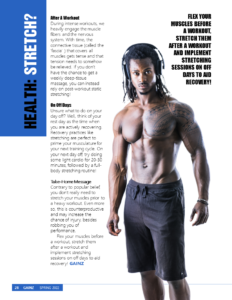Should You Stretch?
Stretching can be done at almost any time, but you should keep certain factors in mind.
Stretching is widely regarded as a means of improving flexibility and preventing injury. But for many, it’s just a dull routine before exercise.
Stretching can be pretty boring, so often people rush through their exercises without really thinking about the reasons behind implementing certain practices before their workout. But truth be told, it’s not just a pointless activity as it can greatly help with recovery and the overall feeling of your muscles.
In this article, we’ll give you insight on the types of stretching one can do, as well as WHEN you should do it! Without further ado, let’s get to it!
TYPES OF STRETCHING
Stretching is divided into two main categories: Static Stretching and Dynamic Stretching.
STATIC STRETCHING
This type of stretching consists in holding a position for a prolonged period of time to achieve physical flexibility.
Stretches are usually held at the maximum point of tension for 30 seconds, causing muscles to relax. This type of stretching is perfect to do after a workout when you are trying to relax the musculature.
However, you should avoid doing this before a workout and instead, focus on exercises that focus on the opposite side of muscular contraction – The activation!
DYNAMIC STRETCHING
In contrast to static stretches, dynamic stretches have a natural flow of movement as their main purpose is to prepare the body for activity.
Dynamic Stretching is a type of exercise that moves the muscles and joints through a full range of motion, coordinating multiple muscle groups in order to increase overall flexibility. Not only does this help with your flexibility, but it also serves as a great warmup before any workout!
When To Stretch?
So now you know what types of stretching there are. But do you know when you should stretch? Stretching can be done at almost any time, but you should keep certain factors in mind.
HERE’S OUR LIST (In no particular order):
Before A Workout
Contrary to popular belief, static stretches are in fact counterproductive if you do them before your workout. This is simply because static stretching relaxes the musculature and brings the feeling of relaxation. Of course this is counterproductive to an intense workout, where the goal is to progressively recruit and activate more and more muscle fibers.
If you do stretching before a workout, make sure to do dynamic stretching, rather than static stretching. Dynamic stretching, as mentioned previously, is perfect for muscle activation, thus preparing the musculature for the workout ahead.

FLEX YOUR MUSCLES BEFORE A WORKOUT, STRETCH THEM AFTER A WORKOUT AND IMPLEMENT STRETCHING SESSIONS ON OFF DAYS TO AID RECOVERY!
After A Workout
During intense workouts, we heavily engage the muscle fibers and the nervous system. With time, the connective tissue (called the ‘fascia’ ) that covers all muscles gets tense and that tension needs to somehow be relieved. If you don’t have the chance to get a weekly deep-tissue massage, you can instead rely on post-workout static stretching!
On Off Days
Unsure what to do on your day off? Well, think of your rest day as the time when you are actively recovering. Recovery practices like stretching are perfect to prime your musculature for your next training cycle. On your next day off, try doing some light cardio for 20-30 minutes, followed by a full-body stretching routine!
Take-Home Message
Contrary to popular belief, you don’t really need to stretch your muscles prior to a heavy workout. Even more so, this is counterproductive and may increase the chance of injury, besides robbing you of performance.
Flex your muscles before a workout, stretch them after a workout and implement stretching sessions on off days to aid recovery! GAINZ

About the Authors:

GAINZ STAFF
Freelance industry experts from around the world.

Natural GAINZ Magazine – Massive Pecs! Chest Training With IPL Pro Champion, Nifai Tonga
“These are the exercises that help me dominate on stage.”

Natural Bikini Magazine – Three Post-workout Recovery Tips
Whether you’ve just hit up a gym session, spin class, or outdoor run, there’s nothing like giving your body the care and attention it deserves after all that sweat and sweet exertion.

ATHLETIC Magazine – Why Training Is Mandatory For Adults
“There is age, measured in years. Then there is biological age. Two people at 60 may look entirely different.”

Natural GAINZ Magazine – New IPL Women’s Athletic Pro Tiffany Gates Dominates!
“It was completely emotional. I was surprised, thrilled and overwhelmed all at once.“

Natural GAINZ Magazine – Five Protein Supplements For Fast Muscle Growth
If you are looking to pack on some muscle, protein is one of the essential nutrients your body needs.

Natural GAINZ Magazine – IPL Evening Gown Pro, Simona Nelson
“I knew what I wanted to improve, discussed it with my coaches and hit the ground running.”
